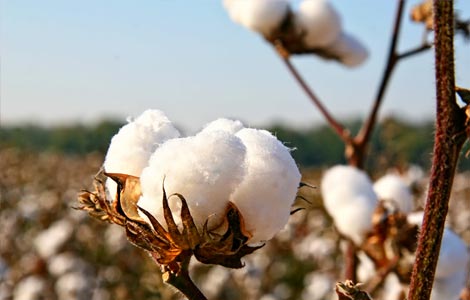
- Boron is essential for all plant growth. It is important for cell wall structure, root growth, and pollination.
- Cotton requires an adequate available supply of boron—especially during the boll development stage. Without sufficient boron, boll shedding in cotton may occur, reducing yields.
- Multiple foliar sprays of Solubor® applied alone or with insecticides will ensure an adequate supply of boron during flowering and boll development.
- Preplant soil application of Granubor®plus foliar sprays of Solubor during the growing season are recommended for soils testing low in available boron.
The nutrient requirements of cotton are well known, and methods of fertilizer application and other cultural practices resulting in better cotton yields have been developed over the past 50 years. Boron (B) has been universally recognized as the most important micronutrient for cotton production. While boron is essential for all stages of plant growth, an available supply is most important during flowering and boll development. This is especially true with today’s fast-fruiting, high-yielding varieties.
Cell wall strength, cell division, fruit and seed development, and sugar transport are plant functions related to boron. Improved fiber quality (fineness, uniformity and strength) has been reported with boron applications. While the optimal levels of boron in cotton are low as compared with those of nitrogen (N), phosphorus (P) and potassium (K), the need for boron is especially significant in flowering and boll development.
Boron deficiency in cotton: symptoms
Because boron is vital to flower formation and seed production during the boll development stage, a decrease in boron supply during this critical stage can result in decreased yields. New flowers are distorted and there may be excessive shedding of squares. The sepals around the bolls also may fail to harden with low levels of available boron.
Visual symptoms, indicating severe boron deficiencies in cotton, are rarely found in cotton producing regions where boron has been applied in previous years. These symptoms include bushy plants with young leaves which are thicker and darker green. Leaves may be misshapen and distorted with short and brittle petioles.
Soil tests and plant analyses
Boron deficiencies may be suspected on coarse-textured soils where organic matter content is low, on recently limed soils, and where delayed maturity has been reported in cotton with recommended nitrogen rates. Soil testing and plant analyses are both helpful in assessing the potential boron-supplying capacity of the soil and the current boron status of the growing plant.
The critical level of hot-water-soluble boron for cotton in most soils ranges from 0.2 to 1.0 ppm, depending on the soil pH, organic matter content and texture. Soils which are below the critical level generally will respond to applied boron. The critical level of B in upper mature cotton leaves is about 15 ppm. Cotton plants with leaf boron contents below the critical level should be sprayed one or more times with Solubor after flower initiation and during boll development.
DOWNLOAD PDF FOR CHARTS
Best fertilizers and recommendations for cotton
Boron applications should be made every year for cotton because soluble boron can be easily leached from the root zone, especially in sandy soils in high rainfall regions or with over-irrigation. The availability of boron in acid soils generally decreases when these soils are limed, so boron is recommended on freshly limed soils. Response to applied boron generally is greatest when there are adequate supplies of the other nutrients, especially N.
Data below show increased cotton yields with soil and foliar applications of boron in Tennessee. Foliar applications of Solubor (providing 0.1 lbs of B/acre per spray) resulted in a 9% increase over the check, and inclusion of K in the boron foliar spray resulted in a 13% increase. Doubling the boron foliar rate did not increase yields, but the boron petiole concentration was significantly increased. Cotton lint yields also were increased by a preplant soil application of boron.
If you need more help selecting the best boron fertilizer for your cotton crop, contact our team.
DOWNLOAD PDF FOR CHARTS
Download Agronomy Notes